
Ship Science & Technology - Vol. 17 - n.° 33 - (9-19) July 2023 - Cartagena (Colombia)
DOI: https://doi.org/10.25043/19098642.238
David Naranjo Tabares1
José María Riola Rodríguez 2
1Escuela Naval de Cadetes “Almirante Padilla”, Cartagena D.T y C, Colombia. Email: david.467@hotmail.com
2Escuela Naval de Cadetes “Almirante Padilla”, Cartagena D.T y C, Colombia. Email: chema.riola@rga-psi.es
Date Received: November 18th, 2022 - Fecha de recepción: 18 de noviembre de 2022
Date Accepted: February 16th, 2023 - Fecha de aceptación: 16 de febrero de 2023
Environmental logistics in Colombian river areas requires solutions that allow economic development based on tourism, without ecological degradation. Therefore, this paper shows the most relevant aspects of the project and preliminary design of a Pontoon-type vessel with a catamaran hull of 8 meters in length with enough power to reach a speed of 5 knots (85%MCR) and built in aluminum, which will also have electric propulsion based on a hydrogen fuel cell, and using renewable energies such as solar panels on the roof and a wind turbine. One of its main characteristics is that it will be a pollution-free ship and its classification will be done following the regulations of the Bureau Veritas, and all those national and international regulations that are applicable. Due to the problems generated by the daily use of the different means river transportation, which undoubtedly, could generate an irreversible affectation to the environment and a considerable loss of biodiversity in aquatic ecosystems, which worsens over time, this prototype design might be presented to national shipbuilding, as a possibility for designing eco-friendly tourist vessels for the country's river areas, as an example for future constructions that are expected with the rise of tourism in the country.
Key words: Naval Architecture, Design, Hydrogen fuel cell, Pontoon, Catamaran, Environment.
La logística medioambiental en las zonas fluviales colombianas requiere soluciones que permitan el desarrollo económico basado en el turismo, sin degradación ecológica. Por ello, esta investigación muestra los aspectos más relevantes del proyecto y el diseño preliminar de una embarcación tipo Pontona con casco catamarán de 8 metros de eslora con la potencia suficiente para alcanzar una velocidad de 5 nudos (85%MCR) y construida en aluminio, que además cuente con propulsión eléctrica basada en una pila de combustible de hidrógeno, y utilizando energías renovables como paneles solares en la cubierta y un aerogenerador. Una de sus principales características es que será una embarcación libre de contaminación y su clasificación se hará siguiendo la normativa del Bureau Veritas, y todas aquellas normativas nacionales e internacionales que sean de aplicación. Debido a la problemática que genera el uso cotidiano de los diferentes medios de transporte fluvial, que sin lugar a dudas, podría generar una afectación irreversible al medio ambiente y una pérdida considerable de biodiversidad en los ecosistemas acuáticos, que se agrava con el paso del tiempo, este prototipo de diseño podría ser presentado a la construcción naval nacional, como una posibilidad de diseño de embarcaciones turísticas ecológicas para las zonas fluviales del país, como ejemplo para futuras construcciones que se esperan con el auge del turismo en el país.
Palabras claves: Arquitectura naval, Diseño, Pila de combustible de hidrógeno, Pontona, Catamarán, medio ambiente.
In 2019, the tourism sector was the second largest generator of foreign exchange in the country, and the national government began to invest several efforts in it, to arouse the interest of businessmen and investors from all over the world, expecting a special boom in tourists in regions with river areas in the country, with high environmental interest (Santoro, 2019). Considering that situation, it is important to invest in research and development of products that enhance tourism in the country, while adequately protecting the environment. The main function of the tourist pontoon to be designed is the performance of tourism functions in the rivers located in regions with high ecological value, that are protected from contamination. For example, one of the rivers where the project can be implemented is the Bita river, which is protected in Colombia. Here, the State and other social actors must take measures before the water resources suffer irreversible damages, including the loss of species that benefit from that specific environment, such as jaguars, dolphins, giant otters, turtles and “arawanas” (Colprensa, 2015). This is one of the fundamental missions for both the Colombian National Navy and the different tourism companies, that seek compliance with standards that protect these pollution-free areas.
Hydrogen abounds on Earth and could be produced in quantities that satisfy demands of all means of transportation. If it is produced through renewable energies, it could be the fuel of the coming decades. Fuel cells are directly associated with hydrogen, and propulsion systems based on them appear to be the most immediate clean solution to fuel alternatives.
This project seeks to implement an electric propulsion solution based on a hydrogen fuel cell, which is also able to operate in rivers located in protected areas of the country. For this development, the physical and chemical properties of hydrogen, its production, storage systems, the operating principle of fuel cells (Balbona, 2014) and all relevant studies for the design of the vessel must be covered, such as, hydrostatic curves, structural calculations and ship weight, design of electrical generation and distribution, and the design of propulsion and auxiliary systems. These bases must be clearly reflected due to the importance of hydrogen technologies (Valdés et al, 2018), being essential in the future of electricity production to solve the problem of greenhouse gas emissions, and particularly CO2, which causes huge environmental damages.
According to the National Center for Experimentation of Hydrogen Technologies and Fuel Cells of Spain (CNH2), a fuel cell (FC) is an electrochemical device that transforms chemical energy directly into electricity. It starts with a fuel, usually hydrogen, and an oxidant, in many cases oxygen, to produce water, electricity in a continuous electric current and heat. In those fuel cells that consume hydrogen (H2) or which contain a proton exchange membrane or Proton Exchange Membrane Fuel Cell (PEMFC), the current is generated from the reaction shown in the following equation (1) (Leo, 2008).
The fuel is H2 and the O2 would be supplied by the air. It should be clear that it is not an H2 combustion reaction, but rather, an electrochemical process consisting of oxidation-reduction reactions, in which the energy released by the spontaneous reaction is converted into electricity and electrical energy and can be used to make a non-spontaneous reaction occur; requiring electrochemical techniques and microbial fuel cells (Peña, et.al., 2020). FCs are not heat engines; therefore, their operation is not limited by the Carnot yield. Equation (2) shows how hydrogen decomposes at the anodes according to the oxidation reaction and equation (3) shows the reduction at the cathode.
These equations depend on the type of applications for fuel cells. That is, variables such as chemical reactions, the type of catalysts required for the reaction to take place, the range of operating temperatures of the cell and the fuel required, have a direct impact on their applications. (CNH2, 2020).
Fig. 1 shows the different types of fuel cells.
Fig. 1. Types of fuel cells and main characteristics.
These fuel cells present great results such as high efficiency, long-term stability, fuel flexibility, low emissions, and relatively low cost. Fig. 2 shows an example of a fuel cell diagram, and Fig. 3 (see page 12) shows that the efficiency of the cell is little dependent on the size of the system, which allows, in addition to its use in different energy ranges, the design of modular fuel cell systems. Furthermore, they can operate at half load while maintaining optimal fuel usage.
Fig. 2. Solid oxide fuel cell scheme.
Source: Roca, 2021.
Fig. 3. Types of fuel cells.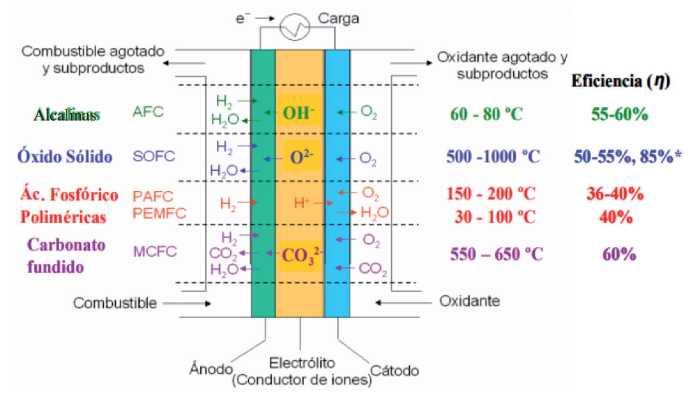
Source: Merino, s.f.
The design process of the vessel was carried out with the support of the concept of the design spiral (Fig. 4), as a guide to achieve a single result.
Fig. 4. Design spiral.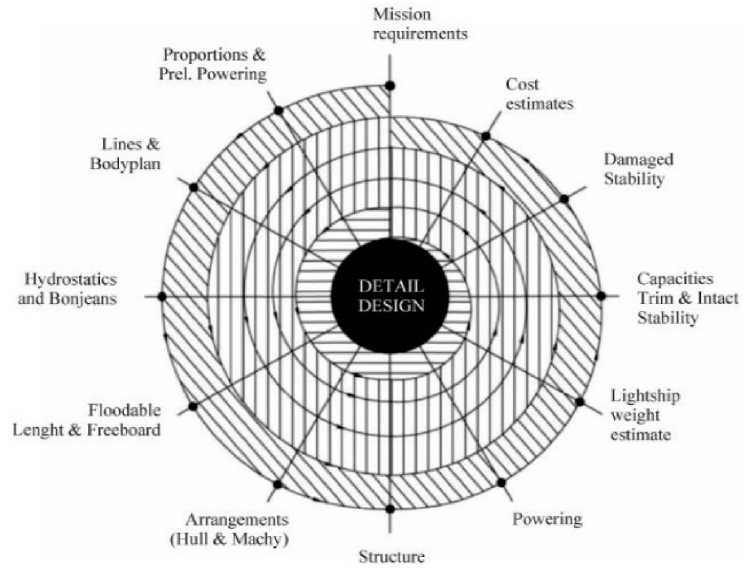
Source: Richard, 2019.
This is the development of the vessel through an optimal and effective process, following an established order which must be respected. Thus, the design tool ensures the adequate proportion and balance of the project. Its viability, approximate budget, fundamental specifications such as its useful life, speed, passenger and crew capacity, vessel limits and type of propulsion were determined. Legal and safety regulations were also identified and applied during the planning of the project.
The aim is for the boat elaboration to be accepted by the nation official entities. Finally, the intention is to present a product ready for construction, with plans that comply with all the legal safe-conducts to allow the project to be executed without any impediment, as shown in Fig. 5.
Fig. 5. 3D tourist pontoon design.
Source: Own source.
For the design of the boat, the Maxsurf Modeler Advanced software was used, especially in the design of shapes and hydrodynamic optimization of Catamaran-type hulls. The Maxurf Resistance and Masurf Stability Advanced for the studies of stability and behavior at sea, and Rhinoceros in the 3D CAD design, where the habitability services and amenities are evidenced were also used. A technological surveillance study was carried out regarding which fuel to use based on the hydrogen vector (Cifuentes el at, 2019), considering the powers needed for a tourist ride, compressed hydrogen would be the fuel used. This simplifies possible logistical problems of some other possible e-fuels.
Because of the need to optimize the life cycle of the ship (Fdez-Jove et al, 2018), to calculate the propulsion system based on the hydrogen cell, the values of the system performances were provided by the United States Naval Academy (USNA, 2001), Fig. 6.
Fig. 6. Propulsive efficiency.
Source: USNA.
The implementation of the battery-based propulsion, based on hydrogen fuel in other types of vessels such as the Hynova 40, had to be analyzed and tested in the Energy Observer, called REXH2 (Range Extender Hydrogen), (Choloé Torterat, 2020), the Ma-Hy-Hy projects (Marine Hydrogen Hybrid) , (Briag Merlet, 2022), the YANMAR vessel, Fuel Cell supported by Toyota Motor Corporation, (Yanmar Holdings, 2021). Data of the operation of the hydrogen fuel cell system and the control of the electric power train during real tests at sea and river areas were collected, evidencing an energy management system that coordinates and controls the operation of the fuel cells, lithium ion batteries and motors (Guerrero, 2022). Fig. 7 shows it in detail.
Fig. 7. Power Managment Controller.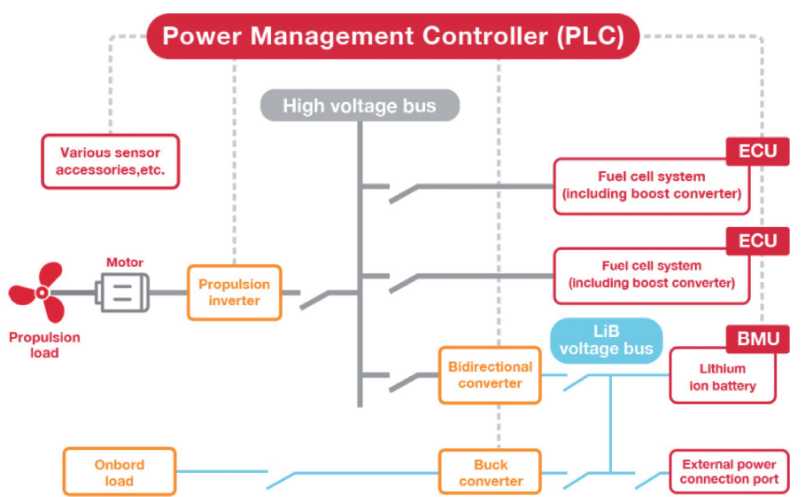
Source: Yanmar Holdings, 2021.
Propulsion system distribution based on hydrogen fuel cell implemented in the tourist pontoon to navigate rivers in Colombia within protected areas would be as is shown in Fig. 8.
Fig. 8. Propulsion system distribution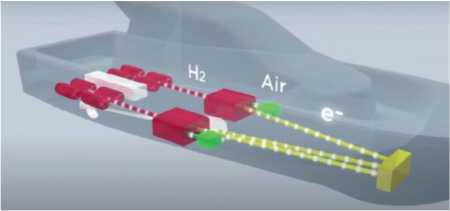
Source: Rock, 2021.
The selection of the fuel cell type was made searching in the supplier market and a PEM type fuel cell was selected, which has a power range of 0 to 250 KW and which is mainly used to feed transportation systems.
The polarization (V) of the fuel cell (Ramírez et al, 2022) is the voltage between the electrodes and is given by the expression shown in equation 4:
Where
N: number of cells in the stack
VAC: open circuit volts
Re: specific resistance
Di: current density
PT: slope of Tafel or graphical representation of a straight-line portion of a polarization curve
C1 and C2 are constants
The battery power in watts responds to the expression shown in equation 5:
where η is the yield and S the cell area.
Amount of hydrogen in kilos required for the PEM-type fuel cell in stack. The following equation (6) is applied in which the following variables must be known:
P= power delivered by the batteries in kW
T= operating time in hours
η= performance of the PEM type battery 0.53%
LHV=lower heating value of hydrogen, 120 MJ/Kg
Commercial cylinders dimensions managed by the company Marine Service Nord (Barón et al, 2022), which comply with the safety standards established by SOLAS (International Convention for the Safety of Life at Sea) were taken as a reference. With the height and diameter of the cylinders, the formula for calculating the volume of a cylinder was used to know the volumetric capacity of each commercial cylinder. With this volume, the variables density and temperature are derived from the pressure. In this case, 700 bar is referenced as the maximum pressure that each type IV commercial cylinder can withstand and thus, the mass of each cylinder. So, for the storage of compressed hydrogen, in a bottle along the length, the conditions were established at 700 bars and 15°C. Fig. 9 is an example of this.
Fig. 9. Hydrogen density-temperature diagram.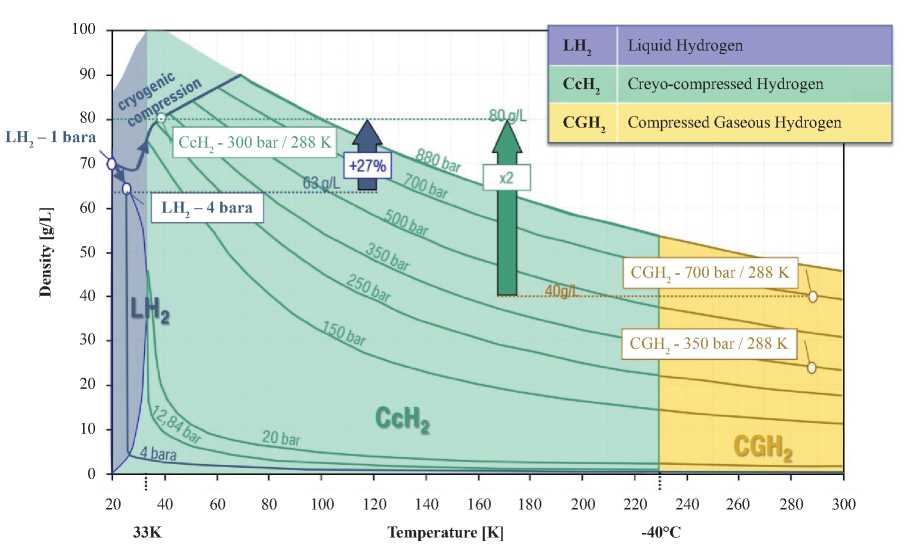
Source: AEH, 2019.
The costs of the exposed project are reflected in the following table (2):
Table 2. Cost analysis.
Source: Own source.

Source: AEH, 2019.
1. AEH. (2019). Tecnologías del hidrógeno. Asociación Española del Hidrógeno. Consultado el 1 de julio de 2022. https://www.aeh2.org
2. BALBONA, L. (2014). Propulsión eléctrica marina con cero emisiones mediante el empleo de una pila de combustible de hidrógeno tipo PEM (membrana de intercambio de protones). [tesis de doctorado, Universidad de Oviedo]. Repositorio institucional de la Universidad de Oviedo, Asturias, España. https://digibuo.uniovi.es/dspace/handle/10651/29126.
3. BARÓN, J, CORONADO, A, RIOLA, J.M. (2022). Diseño del sistema de propulsión eléctrico accionado por pila de combustible para el buque de instrucción ENAP. II Congreso Internacional de Planeación y Logística, Escuela Naval Almirante Padilla, Cartagena de Indias, Colombia.
4. BRIAG MERLET, P. (28 de 04 de 2022). Torqeedo une sus fuerzas para ofrecer soluciones marinas integradas de pila de combustible de hidrógeno. Obtenido de https://www.boatindustry.es/noticias/40145/torqeedo-une-sus-fuerzas-para-ofrecer-soluciones-marinas-integradas-de-pila-de-combustible-de-hidrogeno
5. GUERRERO, L. (2022). Guidelines for fuel cell systems on board commercial ships. Bureau Veritas, París, Francia.
6. CHOLOÉ TORTERAT, P (06 de 08 de 2020). Obtenido de https://www.boatsnews. es/noticias/34418/hynova-40-el-primer-barcode-placer-de-produccion-alimentado-porhidrogeno
7. CIFUENTES, B., BUSTAMANTE, F., COBO, M. (2019). Producción de H2 apto para celdas de combustible a partir de la conexión del reformado con vapor de etanol y la oxidación preferencial de CO. Repositorio de la Universidad Pedagógica y Tecnológica de Colombia.
8. CNH2 (2020). Pilas de Combustible. Centro Nacional de Experimentación de Tecnologías de Hidrógeno y Pilas de Combustible de España. Consultado el 15 de enero de 2022. https://www.cnh2.es/pilas-de-combustible/
9. GODFREY PONTOON BOATS. (2022). Sanpan Lounge 2700 ULW. Obtenido de https://virtualshowcase.godfreypontoonboats.com/godfrey/sanpan/sanpan-lounge-2700-ulw
10. FERNÁNDEZ-JOVE, A., MCKINLAY, A., RIOLA, J.M. (2019). Optimization of the Life Cycle in the warships: maintenance plan and monitoring for cost reduction. Proceeding of the International Ship Design &Naval Engineering Congress (CIDIN) and XXVI Pan-American Congress of Naval Engineering, Maritime Transportation and Port Engineering (COPINAVAL). Singapore: Springer.
11. LEO, T. (2008). Pilas de combustible de hidrógeno. Apuntes de Termodinámica. Universidad Politécnica de Madrid, España.
12. MERINO, R.I. (s.f). Nuevos materiales para sofc's. http://fmc0.unizar.es/people/rmerino/papers/divsofc.pdf
13. NARANJO, D., RIOLA, J.M. (2022). Contaminación cero: diseño de una pontona turística fluvial con propulsión eléctrica basada en pila de combustible de hidrógeno. II Congreso Internacional de Planeación y Logística, escuela Naval Almirante Padilla, Cartagena de Indias, Colombia.
14. PEÑA, S., VILLA, G., RONQUILLO, S. (2020). Capacidad y uso de tecnología: estudio a nivel de los procesos electroquímicos. Revista Venezolana de Gerencia. Vol. 25, N3. https://produccioncientificaluz.org/index.php/rvg/ article/view/33393/35189#
15. RAMÍREZ, D., VÁSQUEZ, O, RIOLA, J.M., (2022). Contaminación cero: la propulsión basada en hidrógeno del buque colombiano de apoyo a catástrofes. The 2022 Multidisciplinary International Conference of Research Applied to Defense and Security, MICRADS'22, Barranquilla, Colombia.
16. ROCA, J. A. (17 de 07 de 2021). El periódico de la energía. Obtenido de https://elperiodicodelaenergia.com/la-estonia-powerup-lanza-un-generador-portatil-de-pila-de-combustible-de-hidrogeno-con-una-potencia-de-400-w/
17. SANTORO, F. (31 de enero de 2019). La hora del turismo para Colombia. La República. https://www.larepublica.co/analisis/flavia-santoro-2807402/la-hora-del-turismo-para-colombia-2822338
18. VALDÉS, R., RODRÍGUEZ, L.R., TRICIO, V.,LUCIO, J.H. (2018). Nociones elementales y problemas docentes sobre la producción y utilización de hidrógeno electrolítico obtenido mediante fuentes renovables de energía. Latin- American Journal of Physis Education. Vol.12,No.3. https://dialnet.unirioja.es/servlet/articulo?codigo=6957415
19. YANMAR HOLDINGS. (2021). Sistema de pila de combustible de hidrógeno. Obtenido de https://www.yanmar.com/co/about/ technology/vision1/fuel_cell_system/
20. USNA. (2021). United States Naval Academy. Consultado el 1 de julio de 2022. Obtenido de https://www.usna.edu/NAOE/_"les/ documents/Courses/EN400/02.07a%20 Ch7%20HW%20Solutions.pdf
21. LUCO, R.L, FLORES, R.T, BAOS, R.O. (2019). Naval Architecture — From Theory to pratice. Ship Science &Technology - Vol. 13 - n°25 - (27-35) July 2019 - Cartagena (Colombia) 27.
22. COLPRENSA, (2015). El Bita primer río protegido de Colombia. https://www.elcolombiano.com/medio-ambiente/el-bita-primer-rio-protegido-de-colombia-NJ1380249.
23. DÍAZ, M.P (2023). Balance 2022: turismo en Colombia alcanza cifras prepandemia. https://colombia.ladevi.info/colombia/balance-2022-turismo-colombia-alcanza-cifras-prepandemia-n47349